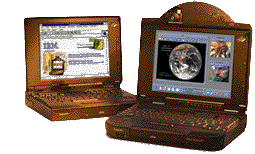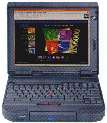

It all started on June 19, 1995, when IBM officially announced the ThinkPad Power Series 800 line of computers. It consisted of two models: the 820 (above left) and the 850 (above right). Both machines were built around the PowerPC 603e CPU running at 100Mhz. Both machines were amazing for their time, blowing away the dominant Intel 486 and emerging Pentium notebooks. Both included a superb 10.4 inch color TFT black-matrix display, large SCSI hard disk, 2X CD-ROM drive, 16-bit sound with stereo speakers and an impressive 48/96 MB memory capacity. The 850 even included built-in video capture hardware which enabled video conferencing and recording of TV video signals to MPEG and AVI formats!
All these features came at a price, however. The 850 weighed 10+ lbs which is pretty heavy for a notebook. Scariest of all was the price: upwards of $12 000 US$ for the 850. This pretty much guarenteed sales would be limited to the intended power business user market.
Newsflash! There appears to have been an earlier model that wasn't widely available. I have a confirmed report of the existence of a model 800 (6020) that appears to be a predecessor to the 850. Information on this model is scarce. Thanks to Daniel Thompson ( danielthompson at earthlink.net ) for the initial report! See the capabilities page for more details.
The ThinkPad notebooks (and the desktop Power Series computers) were handled by the then-new Power Personal division at IBM. This division was separate from both the RS/6000 and PC division but, because of its unique nature, maintained strong ties to both divisions. Perhaps this tug-of-war between divisions was the harbinger of doom for the fledgling division. Since it didn't have the marketing and support infrastructure in place it relied upon the PC and RS/6000 divisions to cover much of its operations. As a result, each side passed off responsibility to the other and the vision behind the line got blurred.
While four operating systems were slated to be released for the machine, only two -- AIX and Windows NT -- were widely used . OS/2 eventually was released for the PowerPC, but only in a limited way and it wasn't promoted. It is rumoured that you can get a copy if you pester IBM enough. As for the fourth OS, Solaris was officially announced for imminent release February 20, 1996. From what I understand, Solaris for the PowerPC never really caught on. It was withdrawn from marketing July 22, 1997. As a result, almost all of the machines out there are running AIX or NT. Recently, Linux has been ported to the PowerPC-- definitely a positive development. I have yet to confirm it actually running on the ThinkPads.
Unfortunately, in 1996 the Power Personal division was shutdown and folded into the PC and RS/6000 divisions. This further confused the situation by arbitrarily splitting up support between the divisions. Hardware support was handled by the PC division and software support varied depending on whether you were running AIX or NT. Most support employees were never really informed about these changes and most calls to IBM would end up in an endless loop of phone transfers: "Machine type 60xx? Oh that's the other division's responsibility!"
The PC division never did anything else with the PowerPC until they dropped it, but the RS/6000 division took up the line and came out with the upgraded models 821/822/823/851 and later the model 860 (below) running at 166Mhz and with a bigger display. In 1997 the RS/6000 division dropped the 860 and up to this day there is no scheduled replacement to continue the PowerPC ThinkPad line.

Please inform me of any factual errors, additional info or comments. I'd like to see this page evolve into a complete, precise and definitive history.